Sedum palmeri by Marco Cristini
Erat enim instar ac si mundus ipse, excutiendo semet, reiecta hieme,
passim auream florum vestem indueret.
It was as if the world, shaking off the winter,
wore a golden dress of flowers in every direction.
(Rodolfus Glaber, Historiarum Libri, III, 13; slightly modified text )
Sedum palmeri Watson is a crassulacea of Mexican descent fairly widespread in Italy. It grows on the windowsills of houses and apartment buildings in many cities and it's able to survive outside during the colder months. Many people can see, around March, its yellow flowers, which indicate the ( long-awaited ) end of winter. However, few people know that it is a succulent plant, a relative of Sedum album and Sedum morganianum.
Sedum palmeri was described for the first time by the botanist S. Watson on the Proceedings of the American Academy of Arts in 1882. The name of this crassulacea remembers Edward Palmer (1829-1911), an American botanist who, in the course of the nineteenth century, led several scientific expeditions in Mexico. Today it is estimated that, during his explorations, he has collected approximately one hundred thousand specimens of plants and he has discovered a thousand new species. Also interested in archeology and Mexican culture, Palmer studied the way in which local people were using succulent plants, thus contributing to the birth of modern ethnobotany.
Returning to Sedum palmeri, this crassulacea grows in Mexico in the states of Coahuila, Guanajuato, Hidalgo, Nuevo Leon, San Luis Potosi and Tamaulipas (Garcia & Chavez, p. 63). Eggli (p. 304) writes that it is naturalized in Italy. Personally, I have seen sometimes S. palmeri growing in abandoned buildings or in abandoned gardens, but never far away from places where it had been intentionally introduced by humans. However, my observations are limited to Northern Italy: it is possible that in Southern Italy, considering the milder climate, the succulent has spread further from the most humanized places.
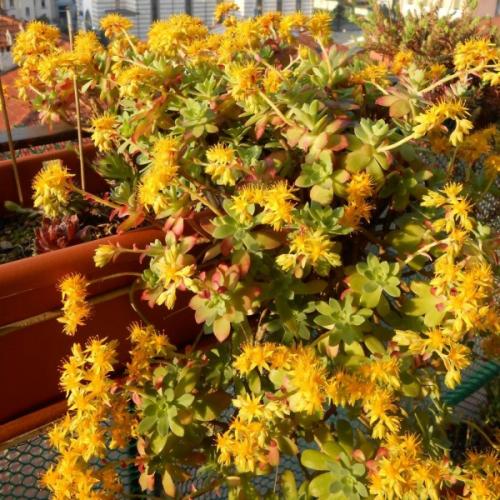
With regard to the taxonomy, this crassulacea puzzled a lot the botanists. In 1981, in fact, Clausen has joined Sedum palmeri and Sedum compressum, two species having very similar features. Ray Stephenson agrees with this change, believing that S. palmeri and S. compressum are a single polymorphic species (Stephenson 1994, p. 239). Eggli, however, keeps the two species as separate entities (Eggli, p. 255 and p. 304). The taxonomy is further complicated by the presence of two subspecies: Sedum palmeri var. emarginatum RT Clausen (1981) and Sedum palmeri var. rubromarginatum R. T. Clausen (1981). Eggli does not recognize these taxa, while Stephenson describes in detail the differences. I have had the opportunity to grow for two years S. palmeri ssp. emarginatum and I must say that there are several differences (which will be treated better in the continuation of the article) with S. palmeri sensu stricto, but it is best to leave these taxonomic debates to people who are more competent.
Sedum palmeri 'Compressum :
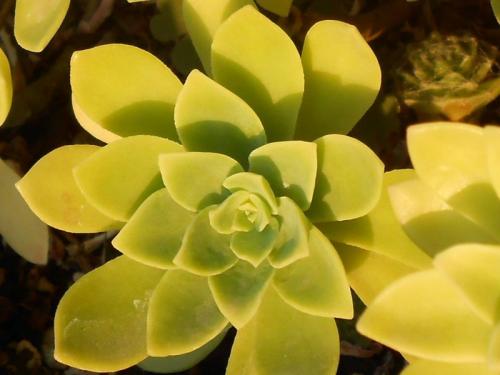
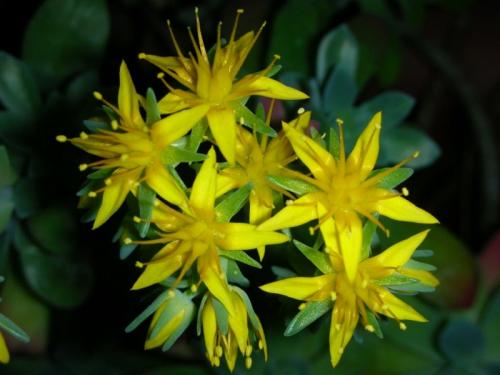
Sedum palmeri is a perennial crassulacea, which forms small clumps of rosettes, arranged more or less thickly depending on the insolation, the substrate and watering. Its stems are 25-30 cm long. They're erected at the beginning, but soon become decumbent, giving rise to real waterfalls of plants, which makes this succulent suitable for hanging baskets. The average diameter of the rosette is about 3-4 cm, but it is not unusual to find wide specimens less than 2 cm (under stress ) or more than 8 cm (if the succulent is in a shady position and has plenty of water available). The leaves are obovate, slightly spatulate, without bloom, pale green, with rounded apex, sometimes slightly pointed. In the winter, they have a tendency to turn red. Their size, as already mentioned, changes widely: medium-small specimens have leaves 14-15 mm long and 6-7 mm wide, medium and large plants arrive at 35-38 mm x 13-14 mm. The inflorescences, which are formed during the winter and bloom in March-April, are paniculate, with two or (more often) three racemes. They are 4-8 cm long and are adorned with bracts varying in size (again depending on the greater or lesser prosperity of the plant), ranging from 9-10 x 3-4 mm to 20 x 9 mm. The flowers, with a diameter of 2 cm, have 5 green sepals, 6-7 mm long (almost as long as the petals), 1-2 mm wide, lanceolate, subacute; 5 yellow petals 8-9 mm long, 2 mm wide, oblong- lanceolate, slightly keeled, with the apex acute; 10 stamens 5-6 mm long, with yellow anthers and filament; 5 yellow pistils, 5 mm long.
Sedum palmeri 'Compressum' - plants reddened by winter frost :
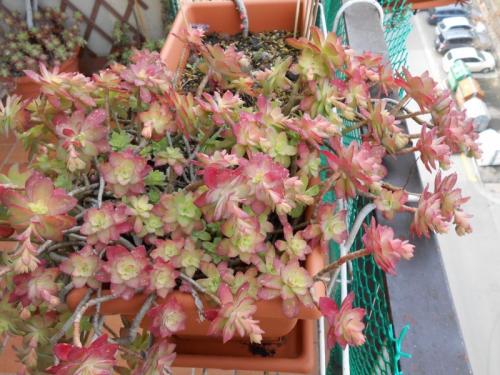
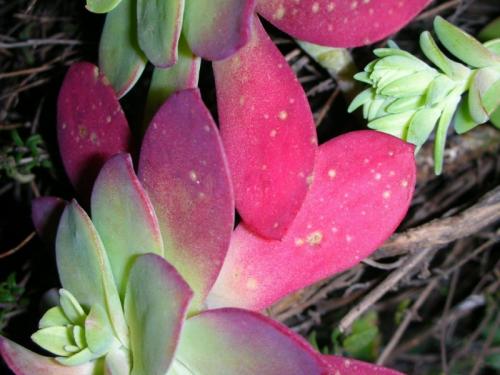
The cultivation of S. palmeri is very easy. The succulent grows on any type of substrate and has no need of frequent watering or fertilizing. Of course, the more plants are treated with care, the more their appearance improves, but I saw several pots of S. palmeri left to themselves still in excellent condition. In any case, it would be appropriate to grow this sedum in a rich substrate (not the one commonly used for cacti). In this way you will get faster and more plentiful growth. Multiplying S. palmeri is simple: stem cuttings root in a few weeks and, if located in a favorable position, immediately develop many secondary branches. Based on what I have experienced, it is not even necessary to rest the cuttings for a few days before planting them: the risk of rotting is minimal. I tried several times to make leaf cuttings or sowing, but they always gave a negative result.
Sedum palmeri 'Emarginatum' :
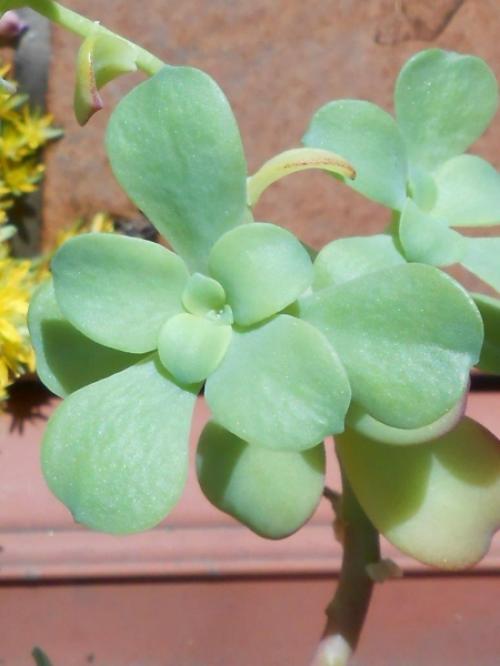
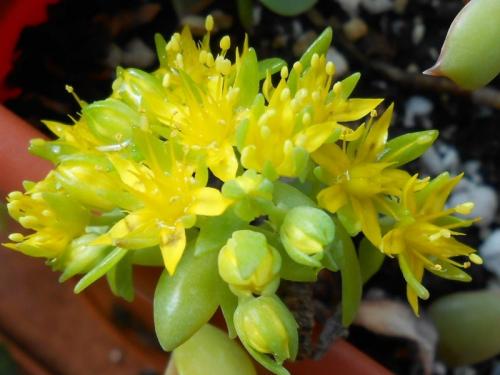
Sedum palmeri is also quite resistant to pest attacks. Aphids can be a problem during flowering, since they often attack the flowers: this is why it is advisable to remove them as soon as possible, once faded. One year I made the mistake of leaving the inflorescences on the plants and the aphids have infested many rosettes. However, these pests are active mostly during the spring months, during the summer they tend to disappear. It may also happen that the mealy-bugs set up on some specimens. In this case the insecticides on the market work little: the leaves of S. palmeri are very delicate and are easily burned by the products with which they have been sprayed. The most effective method is still to manually remove the parasites with a cotton swab or with a thin, pointed object (I use toothpicks). If the infection persists there are two roads to take. Or you delete the infected plants (and sterilize the pot) or you wait, hoping that the winter and the natural predators will kill the insects.
To complete this brief overview of S. palmeri it seems appropriate to mention two varieties of this succulent which have recently come into possession of mine: S. palmeri var. emarginatum and S. palmeri ' Guatemalan Mini '. These crassulaceae are, in my opinion, very attractive and deserve wider presence on our windowsills.
Sedum palmeri S. Watson ssp. emarginatum Clausen (1981) resembles, in size, S. palmeri sensu stricto, but its leaves are more spathulate, with the apex more rounded and slightly paler. These are 4-4.5 cm long, up to 2 cm wide, markedly spatulate, pale green (much lighter than in S. palmeri), with the apex slightly curved into the underside, so that the leaf assumes a somewhat convex aspect. It should be noted that the trunk has the same color of the leaves, with dark (brown – reddish) scars at the points where the leaves were attached, another important element of difference with S. palmeri, which, instead, presents a stem of woody appearance. The inflorescences are 6-8 cm long and carry different flowers with a diameter of about 8-9 mm. Each of them is formed by five sepals quite long (4-5 mm), 1 mm wide, linear, with acute apex, green light; 5 petals linear-lanceolate, 5 mm long, 2 mm wide, keeled, with a slightly darker central stripe, yellow, with apex acute; 10 stamens with filament and anther yellow, 4 mm long; 5 yellow pistils 3-4 mm long. Compared to S. palmeri the flowering is slightly late. As far as the cultivation is concerned, there are no substantial differences with S. palmeri. The growth of the plant, however, appears slower.
Sedum palmeri 'Guatemalan Mini' :
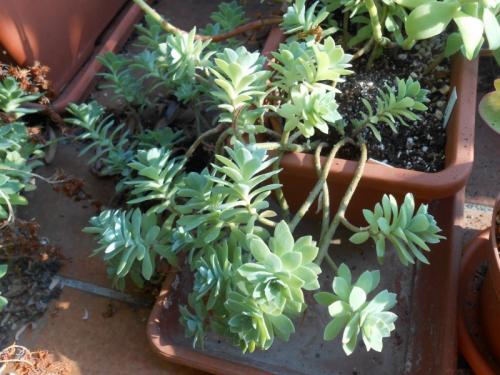
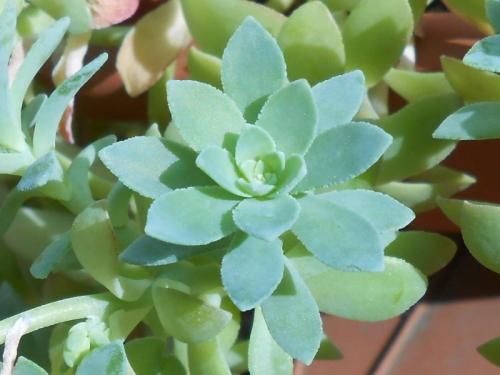
Sedum palmeri ' Guatemalan Mini ' has been described for the first time by Ray Stephenson on Sedum Society Newsletter 90 (pp. 93-94 ). This crassulacea is originally from Guatemala, but its exact origin is a mystery, as has been found for the first time on the stalls of a Guatemalan market. The succulent, as the name suggests, is much smaller than S. palmeri. It consists of several leaves 16-20 mm long and 5-7 mm wide, lanceolate, light green (the same color of S. palmeri), gently serrate margins, with the apex acute. The inflorescences are very abundant and come to bloom almost simultaneously with those of S. palmeri (at the utmost ten days later.) The flowers, about 1 cm in diameter, consist of 5 sepals 5-6 mm long, 1 mm wide, linear, light green, with acute apex; 5 yellow petals 5 mm long, 1.5 mm wide, linear, with acute apex, slightly keeled; 10 stamens 5 mm long, with both filament and anther yellow; 5 pistils 4-5 mm high and yellow. Sedum palmeri 'Guatemalan Mini', as already noticed by Ray Stephenson (2009, p. 94 ), has a particular behavior in cultivation. When exposed to the sun and watered sparingly has a very slow growing, almost non-existent. If, however, it is kept in a shady location (eg on a north-facing balcony) and is watered abundantly, it grows very quickly.
To conclude I would like to mention another advantage of this succulent, more emotional and less objective than those listed here. S. palmeri, in fact, normally blooms in the month of March. Its yellow flowers are, in my opinion, one of the clearest signs that winter is over and spring is upon us. After a long and gloomy cold season it is for me a source of hope to see the buildings of our cities adorned with garlands of yellow flowers. Paraphrasing Rodolfus Glaber (a French medieval chronicler who lived between the Xth and XIth century), it is as if the world were to shake off the winter and cover itself with a blanket of yellow flowers.
Sedum palmeri 'Guatemalan Mini' :
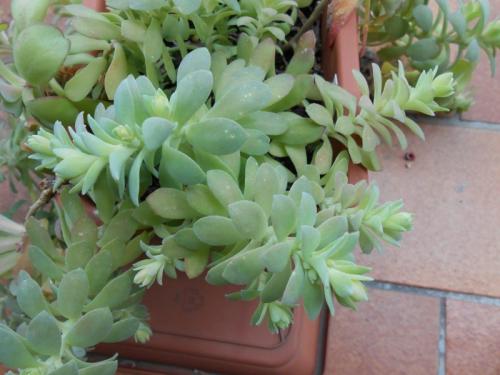
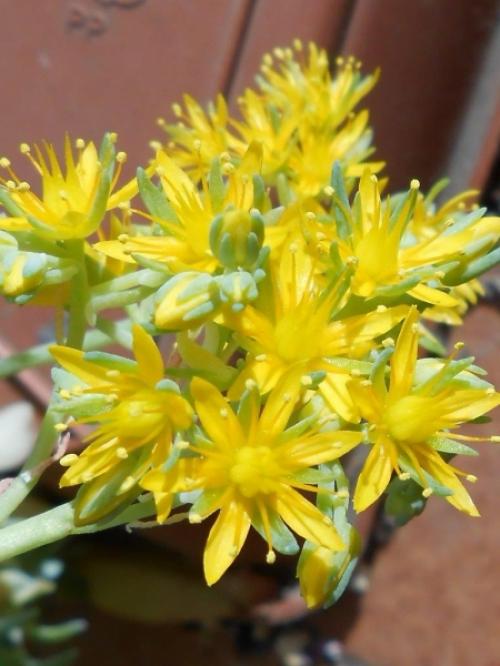
ACKNOWLEDGEMENTS
I'd like to thank Ray Stephenson, who gave me some valuable tips on S. palmeri 'Guatemalan Mini', and Margrit Bischofberger, who generously donated me some plants of Sedum palmeri var. emarginatum and Sedum palmeri 'Guatemalan Mini' belonging to her collection.
REFERENCES
CRISTINI, M., 2012, Sedum palmeri in Italy, in Sedum Society Newsletter 103, pp. 6-8
EGGLI, U. (Editor), 2003, Illustrated Handbook of Succulent Plants: Crassulaceae, Springer Verlag, Heidelberg, Deutschland, p. 304
GARCIA, J. M. & CHAVEZ, L. L., 2003, Las Crasuláceas de México, Societad Mexicana de Cactologia A. C., Azcapotzalco, D. F., pp. 62-63
PRAEGER, R. L., 1921, An account of the genus Sedum as found in cultivation, Royal Horticoltural Society, London, pp. 232-234
STEPHENSON, R., 1994, Sedum Cultivated Stonecrops, Timber Press, Portland, Oregon, pp. 239-240
STEPHENSON, R., 2009, Sedum palmeri ‘Guatemalan Mini’, in Sedum Society Newsletter 90, pp. 93- 94
http://ocp.hul.harvard.edu/expeditions/palmer.html (brief biography of Edward Palmer)
Published in Piante Grasse 34:1 (January-March 2014), pp. 20-27